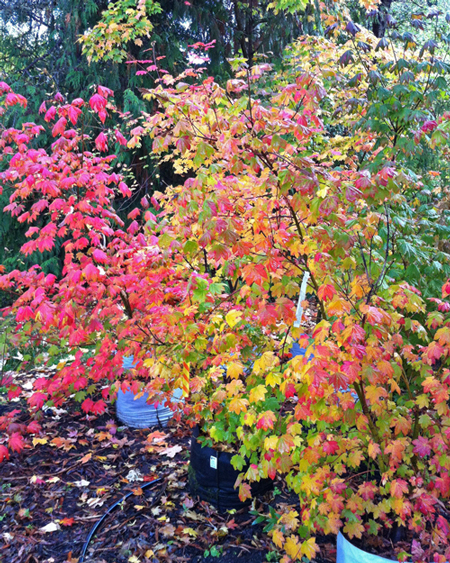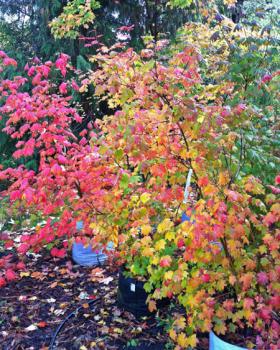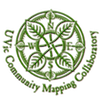VINE MAPLE
Latin name: Acer circinatum
Common names: Vine Maple
First nations names: Hulkemel’em - síits’əłp (upriver)
Family: Aceraceae
Identification:
Vine maple is a small deciduous tree or shrub that characteristically has several thinner trunks that spread, when branches touch the ground it generates roots which can create a thicket. It can reach a height of 7 meters. The leaves have a typical maple shape arrange from 5-12 centimetres wide and have between 7 and 9 lobes. The colour of the leaves in the autumn turn golden in the shade and bright red if in direct sunlight. The fruit of vine maple is joined winged seeds that are 2-4 centimetres long. The flowers are clusters of small white petals with a deep red stem. Vine maple bark is smooth and thin and can be green or a reddish brown [1].


Cautions:
None
Current distribution and local habitat:
Vine maple occurs in the Pacific Northwest, ranging from southwestern British Columbia through Washington and Oregon down to Northern California. It is found in mid to low-elevations in areas with moist or wet soil, often along stream banks. It is shade tolerant and is typically found in the understory, where some sunlight reaches the forest floor [2].
Ethnobotanical uses:
Vine maples have flexible stems that traditionally were used by first nations for drum hoops, snow shoes and fishing nets. The wood is very dense and was carved into bows, small utensils and dishes. The main limitation of the technology created from vine ample is the size of the plant. Coastal first nations also used Vine maple medicinally to treat colds by making a tea out of the bark from the roots. It was also burned to a charcoal and then mixed with water and brown sugar to remediate dysentery and polio [3]. To view a presentation on how to make paint out of vine maple charcoal click here.
Written by Izabella Rae
References:
[1] - Klinkenberg, Brian. (Editor) 2013. E-Flora BC: Electronic Atlas of the Flora of British Columbia [eflora.bc.ca]. Lab for Advanced Spatial Analysis, Department of Geography, University of British Columbia, Vancouver.
[2] - Pojar, J., 1948, MacKinnon, A. 1., & Alaback, P. B. (1994). Plants of coastal british columbia, including washington, oregon & alaska. Vancouver: Lone Pine Pub.
[3] - Parish, R., & Thomson, S. (1994). Tree book: learning to recognize trees of British Columbia. Victoria, B.C: Ministry of Forests.
Image references:
Figure 1 : https://www.plantoregon.com/product.asp?specific=2093
Figure 2 : http://linnet.geog.ubc.ca/Atlas/Atlas.aspx?sciname=Acer%20circinatum
Project Status:
Year:
Associated Projects:
Image:

